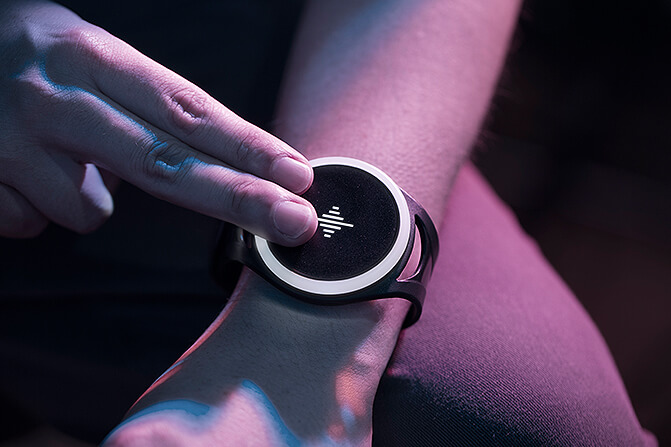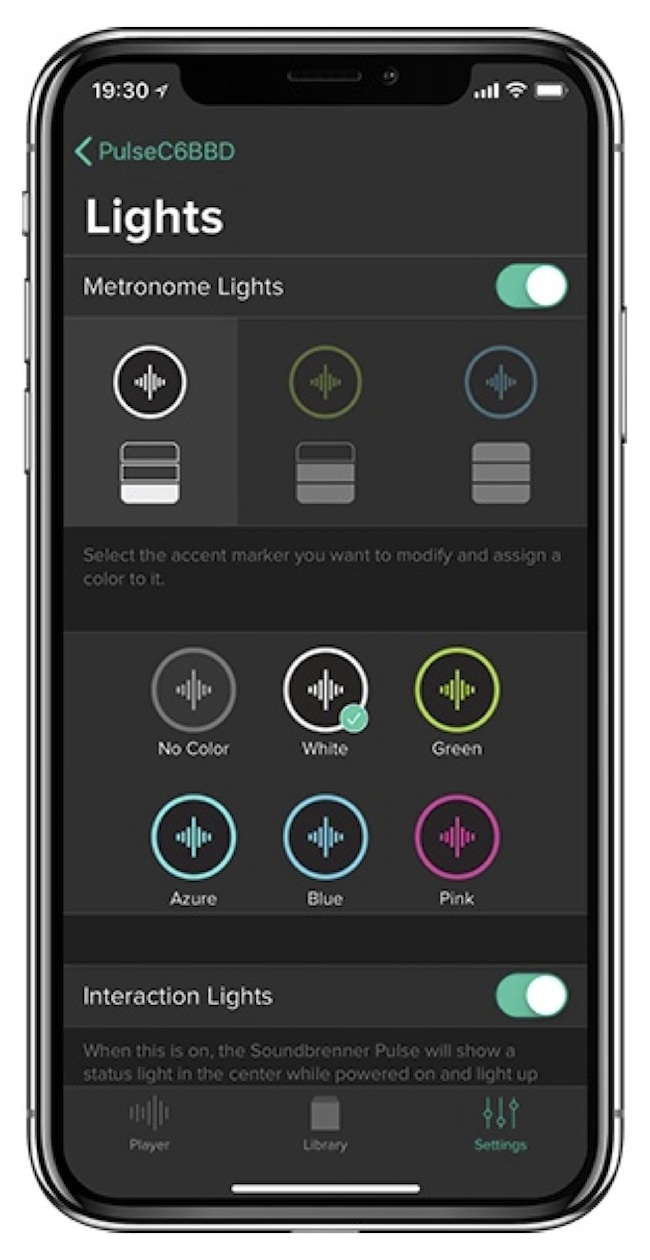New Gear Review: Pulse Wearable Metronome by Soundbrenner

Soundbrenner takes a refreshing and cutting-edge approach to keeping time with the Pulse wearable metronome.
Wearable tech for musicians can be a wonderful tool to help them work, create, and collaborate. Soundbrenner have created Pulse, a wearable metronome watch with diverse uses and features musicians can always have on hand… or wrist, that is!
Unlike most metronomes, one of the many things that makes Pulse unique is that it can be both audible (through the app on your smartphone), or physically felt. Pulse is just that—a pulse that you can feel not only the tempo, but the groove of any particular piece of music. Its controls are at right at your fingertips, so you can adjust tempo up or down, or tap the tempo in at any time. These are just some of the most basic uses of Pulse. Let’s look a deeper look.
Features
Soundbrenner Pulse ships with a couple nice necessities to get you set up; it comes with a USB cable, and both a long and short band in case you want to wear it on your arm or leg for example, instead of your wrist. Pulse works in conjunction with an app, “The Metronome by Soundbrenner” which is free on the App Store and Google Play. This app then allows you to sync up the watch, control it, as well as create different playlists and profiles (more on that below), all via Bluetooth.
The charging can take place via standard wall outlet or USB. The battery provides over 6 hours of play time, which should get most musicians through even the longest gig or practice. The app is compatible with both iPhone, iPod Touch, iPad, and modern Android devices and tablets. Desktop-wise, the team at Soundbrenner have thought of unique features that allow Mac users with Bluetooth 4.0 and later to use Pulse with their DAW—and most major DAWs are supported.
The app makes Pulse highly customizable visually, physically, and functionally. There are LEDs that are synchronized with the vibrations, making the metronome feature just as useful visually as it is when felt. These can be turned off, but you can also set them to the color of your choice via the app. If you want a more traditional audible metronome, the app also offers a variety of metronome sounds that can be played via speakers or headphones.
Even the vibrations themselves are highly customizable in that you can set the vibration intensity, spacing, and accents—per song; there really is a groove to what you are feeling, not just a staccato click. Of course, the Pulse can act as a more traditional metronome without the app, if you just want to practice your instrument and keep a steady Pulse. With the tap tempo feature, you can speed up or slow down the tempo by twisting the watch face, making this a performing musician’s best friend as they run through hours of practice on their instrument.
If you’re in a band or collaborating with others (this might even have interesting applications for musicians working with dancers, or dancers working with composers!), there is a feature to set up songs in playlists or sets, and then sync the entire band/troupe. This makes Pulse indispensable as a silent click for the whole ensemble. Up to 5 devices can be linked up at once, which should cover most bands.
Soundbrenner have also gone the extra beat to make Pulse syncable with most major DAWs via MIDI mapping, as well as Ableton Link. This allows someone, for example, using software like Ableton in their live session to use the Pulse to control their session, or even a particular app on their tablet. (These features are dependent on Bluetooth 4 or a WiFi connection if Bluetooth 4 isn’t an option.)
In Use
Soundbrenner have made navigating the app easy, walking you through account setup and app customization step by step. The walkthrough has featured video content, showing you how to get going with Pulse in a matter of minutes. Setup is so intuitive that you will be grooving along almost instantly, and able to use all the basic features right away.
I wasn’t anticipating Pulse’s song setup features to be so nuanced, but they really were. For example, I set the tempo to the song I was working on, built a song profile for it, and then with a few clicks, created very realistic groove settings and accents. I already had a song I was working on set up in my DAW, and needed to do a few takes of a new part that I was writing. The part sometimes required me to play it in a little slower for accuracy, but I was concerned I would lose the right feel of the piece by playing it slower. Soundbrenner really helped here, as I was able to dial it down on my Pulse, and then play it into my DAW, still feeling the right accents and groove. Later when I was ready, I simply dialed it back up to the original tempo with a few twists of the Pulse’s dial, and then double-checked on the app to make sure that I was back to my original tempo.
The desktop app is also handy in this kind of workflow as it allows you to control select features of your DAW from the Pulse. This works for Bluetooth 4 and up, so be sure to check your computer’s compatibility.
Pulse can really be put to use for musicians of all kinds, in performance, practice, or recording scenarios. Maybe you’re a concert violinist who needs hours of practice before a big performance, or maybe you’re in a band about to hit the road. Apart from really locking in your groove in practice, you’ll also be wanting that same locked-in groove on stage, (and lets be honest, how cool do those blinking colored Pulses look on stage?).
Maybe you’re a DJ spinning original sets from your laptop, turntables or tablet, and need to make sure you can stay in sync. Maybe you’re a solo songwriter writing at home, and want to practice and craft your next hit. Or maybe you’re a composer playing your parts into your DAW as you work through your next film score… all of these are perfect applications for the Pulse, and I am sure that there are more.
To Be Critical
Pulse is a very practical tool, and is intuitively laid out with musicians of all beats in mind. Pulse’s strengths lie in how useful, customizable, and broad its applications are. That said, there is still room for development with this great tool, much of which has to do with some of its more advanced and in-depth features.
I had some difficulty getting Pulse to work with Ableton Link and my iPhone 6S. If you are looking to use some of the more advanced features, be sure to check which OS you’re running with the updated Soundbrenner Metronome app and your DAW for compatibility.
I was using Ableton 10.1 for my tests, but I did not have Bluetooth 4 compatibility, which was fine because I was on my home WiFi network. If I was playing a gig and my laptop, tablet, or phone were older, this might have been an issue (providing that the venue/practice space/studio doesn’t have a WiFi network I can get on), so be aware of that. This however did not stop me from syncing the watch to my phone with Bluetooth, and it should be understood that it is just the advanced features of DAW control, etc., that require Bluetooth 4 or higher.
At one point I downloaded the desktop version of the Soundbrenner Metronome app to test out those advanced features with Ableton. The app downloaded fine, but as soon as installation was complete I received an error message that there was a “Bluetooth 4 Low Energy” issue. Fair enough, but then it wouldn’t go away. I closed it, closed Ableton, but it just kept popping up. I even tried to Force Quit. The issue finally abated after a restart of my machine, and has since not reared its fierce little notification face. Really this isn’t major, and I suspect the team at Soundbrenner may even have this bug fixed soon. In short, don’t install the desktop app if it’s not compatible. If you aren’t sure, check with the Soundbrenner support team, who are very helpful and knowledgeable about some of the nuances of these advanced feature sets.
Lastly—and this is a big one for recording musicians—as great as the Pulse is, I would strongly caution against its use while recording. The vibrations the watch gives off are audible to some extent, and microphones can pick it up! These vibrations can even be transferred through your instrument’s pickups. It’s true that you could choose softer vibration settings, but those would still be captured by most microphones. I think a drummer could probably get away with this, but I would suggest not using Pulse while recording with most other instruments unless they are going through a DI.
Summing it Up
Pulse is a hyper-customizable, wearable metronome that allows musicians to build sets, not just for themselves, but also up to 5 band members or collaborators. The Pulse and its companion app allow for tempo changes, directed from the Pulse or the app, to be done on the fly, and pushed out to the ensemble.
With its many advanced features, you can integrate the Pulse into your workflow in ways other metronomes are simply not capable of, with access to unique features like MIDI mapping, Ableton Link compatibility, and much more. Priced at $99, this is an affordable solution that accommodates many different workflows and types of musicians. Put the Pulse to grooving good use, and keep yourself and your band right on time.
Kallie Marie is a producer, composer and educator who lives in New York.
Please note: When you buy products through links on this page, we may earn an affiliate commission.








[…] Unlike most metronomes, one of the many things that makes Read more… […]